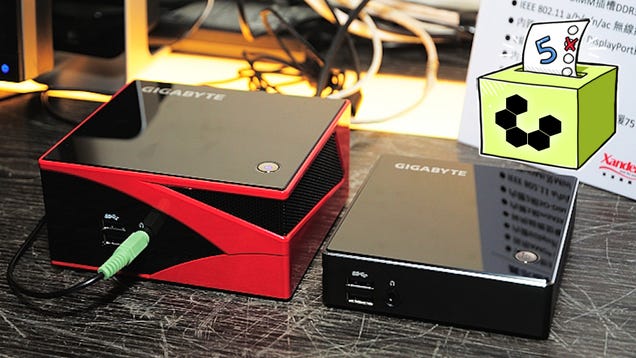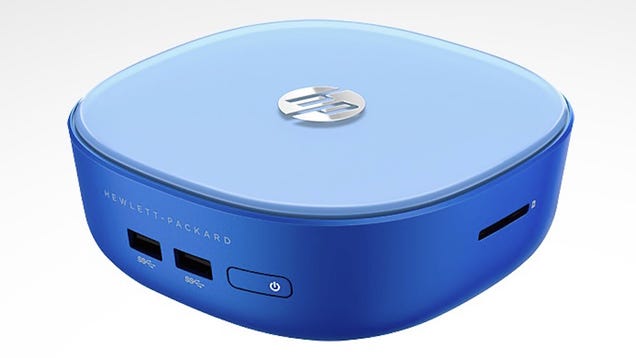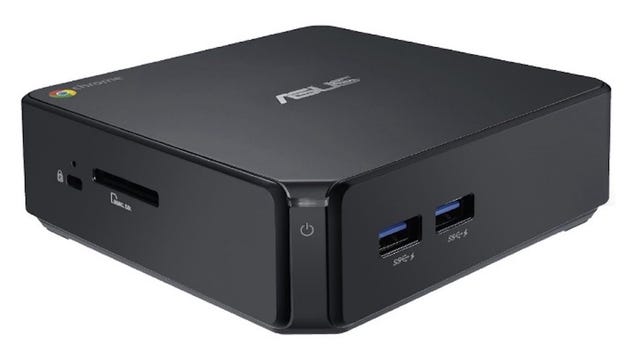Five Best Small Form Factor PCs
If you’re looking for a computer that can fit anywhere and do almost anything, a small form-factor PC is your best bet. The best ones offer power and portability, make the right compromises, and still come in at a good price. This week we’re looking at five of the best, based on your nominations and suggestions.
Earlier in the week we asked you what the best small form factor PCs were. We’re talking about full x86 systems here, so while (as you’ll see in our honorable mentions) there was a lot of love for other platforms, there were plenty of tiny PCs nominated as well that would be perfect for home theater PCs, kids’ computers, office computers, space-saving build platforms, or even modest gaming rigs that don’t take up a lot of space but are still designed to be used with your favorite peripherals.
Here are your five most popular nominees, in no particular order:
HP Stream Mini
The HP Stream Mini earned a lot of praise when it came out for being a surprisingly capable tiny little powerhouse. It fits in the palm of your hand, and our friends at Gizmodo gave it high marks for packing powerful components into a tiny case. The Stream Mini packs an Intel Celeron processor under the hood with 2GB of RAM (upgradable to 16GB), a 32GB SSD, Windows 8.1, Gigabit Ethernet and Wi-Fi, Intel HD graphics, and more into a round, flat computer that fits in the palm of your hand. Of course, you can see the tradeoffs already—storage and RAM are some of the big ones, but the Stream Mini also has a card reader on the front for more storage, four USB 3.0 ports on the front and back of the case, and HDMI and DisplayPort out so you can connect to a monitor or a TV, whatever you prefer. All of that comes at a price tag of $180 direct from HP, and you have a great little machine for a home theater PC, a children’s computer (or a parents’ computer, depending), or a PC that you need to perform lightweight tasks anywhere you don’t traditionally want a desktop, or don’t want to bring a laptop.
Those of you who nominated the HP Stream Mini pointed out that even though it’s a tiny system, it’s extremely upgradable, and those memory and storage shortfalls can be easily improved either before you buy, or long after. Its size and shape make it a perfect HTPC, some of you mentioned, and despite its Celeron processor, some of you noted that it can be quite snappy and speedy—especially once you get something like Kodi Media Center on it, or if you prefer, your favorite Linux distro. You can read more in its nomination thread here.
Intel NUC
The Intel NUC (or Next Unit of Computing) series of mini PCs is more of a form factor than a specific product, mostly because you can order NUCs configured in different ways and in different shapes depending on what you need. That said though, the NUC series shares one thing in common—they’re all small boxes (like the image above) that are small enough to go anywhere, pack Intel Core i3, i5, or i7 processors, and are shipped as “barebone kits,” meaning they’re the perfect platform to add the storage and memory that you need. They’re more expensive than some of the more affordable models, even without drives and memory, but you can choose the processor, size, ports, and other features you need before buying. You can get a look at the various models here, and compare them here. Some of them are all glossy black, perfect for HTPCs, others are grey with removable lids, perfect for upgrading, tinkering, test machines, or secondary computers. If you really need to save cash, there are models with Intel Celeron or Atom processors as well. They almost all pack USB 3.0 on-board, many have card readers for additional storage, and most use HDMI, mini-HDMI, or DisplayPort out so you can connect them to just about any possible type of display. Pricewise you’re looking at between $200-$400 depending on the kit you want, but keep an eye out, they’re frequently on sale.
Those of you who nominated and supported the NUC pointed out that they’re the quintessential kit for PC builders who want something smaller than they could probably build themselves, but also want the flexibility to open them up, customize them, swap out storage and upgrade memory, and really make the system fit the need they have for it. If you want your NUC to be an HTPC, you can add huge hard drives to store music or movies, or skip the storage and opt to stream everything. If you want it to be a portable workstation, you can add more RAM and a little less storage and rely on cloud storage to get by. Just keep in mind you really are getting a kit—meaning all of your peripherals aren’t included. You even have to bring your own power cord. Beyond that, the possibilities are endless. You can check out the nomination thread here.
Gigabyte BRIX
Gigabyte’s BRIX series is another barebones PC kit that you can pick up and then customize with your own preferred storage and memory options. The BRIX are available in workstation, gaming, and budget-friendly models, all in glossy black (with a few of the gaming models in black with bright yellow or red accents.) More than a few of your noted that they’re a bit like higher-end NUCs, with most models shipping with either budget-friendly Intel Celeron processors or higher-end Intel Core i5 or i7 processors, HDMI and mini-DisplayPort video outputs, four USB 3.0 ports, support for up to 16GB (or more) of memory, Wi-FI and Gigabit Ethernet, and Intel HD or HD Pro graphics on-board. Almost all of the higher-end models support discrete graphics, meaning that as long as the card isn’t too big for the case physically, you can install your own graphics card for higher-powered gaming or more graphically demanding tasks. Again, how much you’ll spend depends on which model you choose, but you’re looking at between $300 and $500 depending on the model, which the higher end and gaming models being closer to $500.
Those of you who nominated the BRIX said you loved the look, and that even the budget-friendly options were great as workstations or home theater PCs. You praised them for offering great components in stock, affordable models, and being easy to work on and expand—not to mention that BRIX models have Wi-Fi and Bluetooth modules pre-installed (while other small form factor PCs make you add that on yourself.) You can read more in this nomination thread here, or this nomination thread for one of the higher-end, quad-core BRIX models (the one shown in the image above.)
Alienware Alpha
The Alienware Alpha is a line of gaming PCs that work like consoles—that is, they’re small and flat and are designed to be connected to an HDTV and controlled with a gaming controller as opposed to a keyboard and mouse (although that’s certainly possible too.) The Alpha comes in four different models, each of which includes your choice of an Intel Core i3, i5, or i7 processor, 4GB or 8GB of RAM, NVIDIA GeForce GTX 860M+ 2GB graphics cards, and your choice of 500GB, 1TB, or 2TB SATA hard drives. Gigabit Ethernet, Wi-Fi, Bluetooth, and a wireless Xbox 360 controller come standard with each model, and each model ships with Windows 8.1 pre-installed. The design of the Alpha is typical of Alienware, with the glowing alien head logo in the front, sleek glossy black panels, and red accent notches cut out of one side—it’s small enough to slide in where your HTPC would go, and it’s powerful enough to play a lot of PC games on your big screen with solid performance. Speaking of games, this is very much a gaming system (although you can certainly use it as an HTPC or even a workstation if you choose) and it comes with a number of titles bundled and pre-installed, ready to play. Alienware’s custom UI on the system is designed to work with the controller, and can do everything from launch Steam in Big Picture mode to switch to the HDMI input on the back you can use to daisy chain other input devices or consoles. The Alpha also packs USB ports for added storage or wired controllers. The Alpha starts at $499 direct, but you can catch a break on some of the models at Amazon.
Those of you who nominated the Alienware Alpha praised it for being a powerful gaming PC in an incredibly small and living room-friendly package, packing powerful graphics and a speedy processor in a small, pretty box. Alienware (aka Dell, in case that’s not clear) also allows you to customize your Alpha within some degree, so if you don’t want to stick to the base specs, you can add more RAM, swap in a bigger hard drive, and make a few other changes when you order your Alpha—which you’ll want to do, since they’re not horribly upgrade-friendly once you have them in your hand and set up next to your TV (or on your desk connected to that nice huge monitor you also use for work.) For some of you, the sheer price to performance ratio made this one the winner, but you can read all about that in its nomination thread.
ASUS Chromebox
The ASUS Chromebox was a tricky one to include in the roundup, but just because it ships with Chrome OS onboard doesn’t make it any less of a functional small form factor PC. Depending on the model you choose, you’re looking at between $160 to $200 for the standard models with Intel Celeron processors, 16GB SSDs, and 2GB of RAM, but if you look a little harder you can find Core i3, i5, or i7 powered versions for closer to $300. In any case, the standard models don’t come with a ton of storage or memory, but they are exceptionally affordable, ship with Chrome OS, and include things like card readers for added storage, onboard Wi-Fi and Gigabit Ethernet, USB 3.0 ports, and HDMI and DisplayPort outputs so you can connect them to your TV or your monitor. Chrome OS works just fine as an HTPC (and the Chromeboxes can even be mounted on the back of your TV if you like), and it makes for a great and affordable workstaiton, especially if everything you do is on the web anyway, and you like the idea of an instant-on system that uses your Google account as your single key to everything you need to do.
Those of you who nominated the Chromebox explained that despite running Chrome OS, you could just as easily install linux on it if you want, but if it’s Linux you want, you don’t really have to replace Chrome OS to get it. You also noted that upgrading the RAM in the ASUS Chromebox models is a fairly easy process, and while there’s no drive to be upgraded, it’s such a small, power-sipping, and good-looking box you don’t mind it mounted on the back of your TV or staring at you from your home entertainment center. You can read more in its nomination thread here.
Now that you’ve seen the top five, it’s time to put them to a vote to determine the community favorite:
Honorable Mentions
This week’s most obvious honorable mention goes out to the Raspberry Pi and Pi 2, which are more than capable of running Linux (or Windows 10, if you’re interested in the preview) and functioning as a full desktop system in a palm-sized package. Of course, the Pi is an ARM-based system and we were looking for x86 machines in our roundup, but that doesn’t change the fact that the Pi can do a lot of things that make the rest of these machines great options, and it’s even smaller and more affordable to boot. Of course, you don’t get to really customize your build, but you do get your choice of Pi model, can choose your case, and if you want, can build your own portable computer, a semi-desktop computer, a car computer, a game console, even a smartphone. It’s not exaggerating to say the possibilities are endless.
Our second honorable mention goes out to the a repurposed laptop, or as it was nominated, “a laptop with a broken screen,” which is an awesome DIY project and a way to repurpose any old laptop you might already have lying around. After all, we suggested that particular project not too long ago, so while it wasn’t exactly the type of nomination we were going for, it was good to see it in the nominations anyway. We always did like the way it could be mounted on a slider behind your HDTV so you could slide it out when you needed to access it, then push it back in place when you didn’t need to see it anymore.
Have something to say about one of the contenders? Want to make the case for your personal favorite, even if it wasn’t included in the list? Remember, the top five are based on your most popular nominations from the call for contenders thread from earlier in the week. Don’t just complain about the top five, let us know what your preferred alternative is—and make your case for it—in the discussions below.
The Hive Five is based on reader nominations. As with most Hive Five posts, if your favorite was left out, it didn’t get the nominations required in the call for contenders post to make the top five. We understand it’s a bit of a popularity contest. Have a suggestion for the Hive Five? Send us an email attips+hivefive@lifehacker.com!
Title photo by Sinchen Lin.








No comments:
Post a Comment
Note: Only a member of this blog may post a comment.